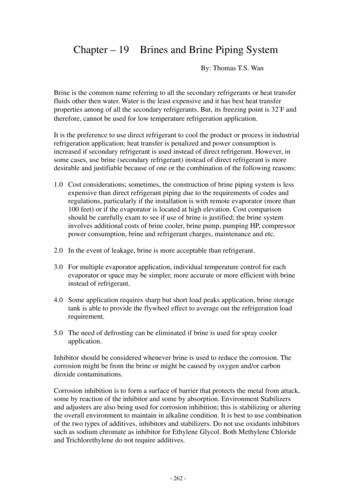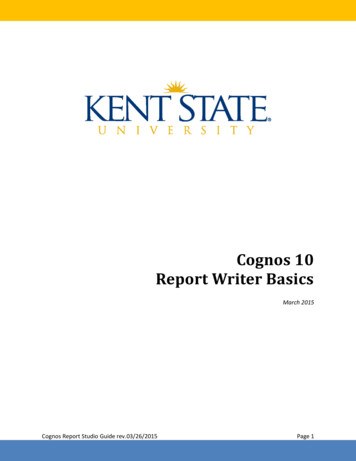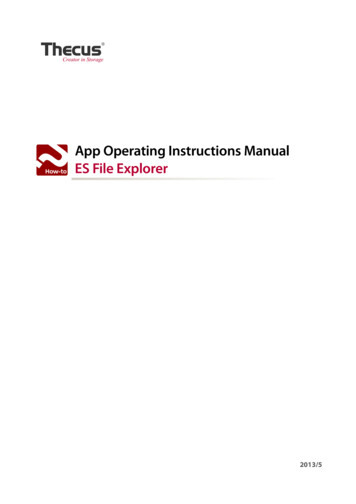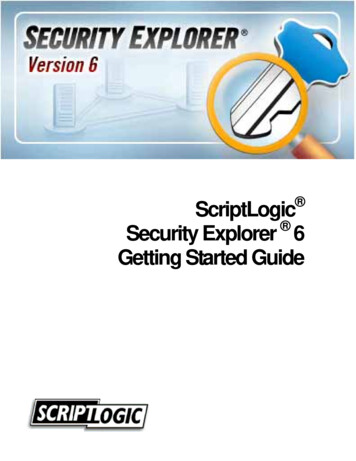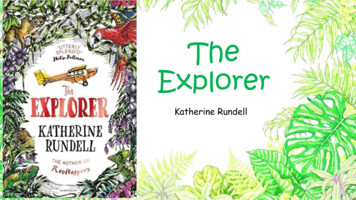
Transcription
TheExplorerKatherine Rundell
The Explorer is a novel about fourchildren who are stranded in theAmazon Jungle when their planecrashes. It is an exciting adventurestory about the children’s struggles tosurvive in a dangerous and completelyunfamiliar place, far from help andother people.
This story of children lost and alone in adangerous place, and their determinationto survive is a genre of story that has beenvery popular over the years. At the heartof this story is a human desire to overcomeadversity and danger, and about howfriendships that last a lifetime can bemade in impossible circumstances.Can you think of any other books or filmsthat have these themes; adventure,survival and friendship?
Preparing to writeAs an author, it is highly recommended that you keep ajotter or notebook, otherwise known as a magpie book,by your side to capture any ideas you may have as theunit unfolds. This book can be used to make notes, jotdown any ideas and draft initial thoughts. The Exploreris a story that is rich in imagery, designed to evokeemotion in the reader. As we explore the story, we willpause and consider how it has been created. Notingdown these tools, trying them out for yourself andtrying to identify them in other fiction, will enhanceyour skills as a writer.
Activity 1: Tuning in to thegenre and exploring the settingBefore we read, let’s think about the genre of the short story.Let’s think about the title:The Explorer1. What words do you associate with explorers and explorations?2. How does the word explorer make you feel?3. What genre do you think this book will be and why?
Now look at the front covers.Do these give you more clues about the story?Which is your favourite cover and why?
Watch this short animation about the book.https://www.youtube.com/watch?v YI YJ4yThPEAs you watch, listen to the background sounds and thinkabout the illustrations on the screen.What do you think the book will be about now?Were your predictions correct?
The book is set in the Amazon Rainforest. You might alreadyknow some things about the Amazon Rainforest. Can you sharethese with the group?Here is a ten minute documentary about the AmazonRainforest. It might help you to imagine the setting.https://www.youtube.com/watch?v JEsV5rqbVNQ&list PLOgbpqEsoxrzo7 afgybspX-GwEA1ZIUAs you watch, make notes about the RAINFOREST and thePLANTS and ANIMALS that can be found there.
Now read the opening two chaptersof the e-rundell-extract.pdfAs you read, listen to the video recording of Mrs Brown, oneof our English teachers at Brine Leas, reading it for you.
Activity 2: Initial responseNow you have read the story, take a moment to reflect on how it made you feel asa reader.Write down your initial responses to the story.You may like to reflect on some of the following elements: what you enjoyed or disliked what surprised, puzzled or intrigued you how the story made you feel what other stories it may have reminded you of what themes lie at the heart of the story What do you think will happen to the children in the rest of the story
Now think back to the work you did in Activity 1.How does the story compare/ contrast to your predictions andyour links to genre and setting?Make a list of the similarities and differences.
Activity 3: VocabularyLet’s revisit some of the vocabulary and turns of phrase within the text.Complete the ‘never heard the word’ grid on the next slide.Have a look at the words and phrases I have chosen and assess yourunderstanding by ticking and commenting in the relevant box. If youknow the word, jot down a definition in your own words.Next, if there are any words that you do not fully understand, look themup and add them, along with their definitions, into your exercise books.Challenge yourself to try to use these words in your own story later onto expand your vocabulary knowledge.
Word or nchesSootSoddenfeverishlyconcussionNever heard of itHeard it but not sure ofmeaningHeard it and here’s adefinition/explanation ofit’s meaning
Activity 3: Establishing the themeAt the heart of any story lies an underlying theme. Sometimes there aremany, entwined through complex plots and backstories, but once you getto the heart of the story, there is always an over-arching theme.In The Explorer, the theme being explored is survival. If you refer tothe survival of something or someone, you mean that they manage tocontinue or exist in spite of difficult circumstances. The survival of aperson means that they live through a dangerous situation.Discuss the theme of survival. How many other stories that youknow or have read explore this theme? What can we learn fromthese characters? Why do you think author choose to explore this instories designed for young children?
Now consider a few books that you love. What are theunderlying themes of each story?For example, the underlyingthemes in: Romeo and Juliet - hatred and love. Beowulf - heroism.As a reader, is there a theme that you enjoy reading about?Consider how this may influence you as a writer. Share yourthoughts with someone and discuss how your interests differor are similar.
Activity 4: ComprehensionWe are now going to revisit the story and try to dig a littledeeper in terms of our understanding.The following four slides have reading strategies that I wouldlike you to explore. For each, you will need to go back and findevidence in the text that supports your opinion. Try to form acalculated, cohesive response. For some questions, it may help ifyou follow this simple pattern:1. Answer the question with a statement.2. Back up your statement with evidence found in the text.3. Explain how the evidence supports your statement.
Strategy 1: SummarisingIn no more than 30 words, write asummary of the extract from TheExplorer. Think about the key eventsthat are instrumental in the story.
Strategy 2: QuestioningRe-read the story and make a list ofquestions you have as a reader.Such as:Where is the plane flying to? What doyou think has happened to the pilot?You may like to question thecharacter’s actions as well as theauthor’s intent.
Strategy 3: Clarifying meaningWhat is your impression of Fred atthe beginning of the story? What ledyou to this opinion? How does yourimpression of Fred change as thestory unfolds?
Strategy 4: PredictingThe story ends on a cliff-hanger.What do you think will happen nextand what led you to this prediction?Have a go at writing the nextparagraph of the story.
Activity 5: Using verbs todescribe your sensesTask 1: a) On a mini-whiteboard or in a notebook,list your five senses.b) Now write a list of sentence starters that youmight use if you were describing your senses in apiece of writing.
Task 2: In pairs, discuss your thoughts about thedescription below. What is effective? What is not effective?I could see the mist rising from the dense undergrowth,like half-formed ghosts. I could feel the heat and dampon my face. It was so hot. I could hear a rumblingsound as if the thunder was getting ready to eruptagain. I could taste rain and feel it on my skin.
In the Junglehttps://www.youtube.com/watch?v ZKSx-6MSWIsTask 3: Working in your groups,list all the things you would beable to sense if you were there.
In your writing, it can be more effective to replacea statement about what you can sense with adescription of that sense using a verb. Consider,for example:I could feel the heat on my face. I could feel rainon my skin.Now think about what the ‘heat’ and the ‘ash’ are DOING:Heat clung to my face. Rain ran from my skin.Task 4: Rewrite your senses from Task 3, adding a verbto explain what the thing you can sense is doing.
Here’s my example to help you:I could see the mist rising from the dense undergrowth,like half-formed ghosts. I could feel the heat and damp onmy face. It was so hot. I could hear a rumbling sound as ifthe thunder was getting ready to erupt again. I could tasterain and feel it on my skin.Smoke rose from the dense undergrowth like half-formedghosts, and heat clung to my face. It was so hot. The tasteof rain invaded my mouth and ran from my skin as thethunder rumbled in the distance, getting ready to eruptagain.
Activity 5 (part 2): Using nounsThere are ten of thousands of nouns in theEnglish language that we use to name things andideas. When we are writing, usually we encourageyou to be as precise as you can be to help yourreader picture what you describe.For exampleGeneric noun carSpecific nouns hatchback, SUV, 4x4, estate,sports car, coupe
Using nounsTask 1: a) On your mini-whiteboard or notebook, listas many jungle animals as you can.b) Now compare your list to your partner’s list. Howmany animals can you add to your list
But what do you do if you don’t know the nounyou need to describe the thing?The children in our story are lost in the Brazilianrainforest. If you suddenly found yourselfthere, would you know all the words you neededto describe the things around you?
Can you draw this creature they found?From one of the branches hung a small animal, unlikeanything Fred had ever seen before. [ ]The animal on the branch let out a mew like a cat. Itwas grey-brown with a cream face, a dog-like snoutand immense black eyes. Its arms were long andchicken-bone thin, ending in curved claws. It was smallenough to cup in your hand.
Did your picture look like this?
Expanded noun phrases to adddescriptive detailNow look again at the description. Together, find all of the nouns.The writer has then added more detail about the size, colour andshape of the nouns to make expanded noun phrases. Find all ofthese details and underline or highlight them in a different colour.From one of the branches hung a small animal, unlikeanything Fred had ever seen before. [ ]The animal on the branch let out a mew like a cat. It wasgrey-brown with a cream face, a dog-like snout and immenseblack eyes. Its arms were long and chicken-bone thin, endingin curved claws. It was small enough to cup in your hand.
Description using similesWe can also use similes to help us.A simile compares one thing with a different thing so that wecan see what characteristic or quality the two things share.We use ‘like’ or ‘as’ to make the comparison. Similes help ussee things in a different way, or imagine something we havenever seen or heard before.Look back at the description of the sloth. Can you find thetwo similes?
Other similes that Katherine Rundelluses: ‘a fern-like plant’ ‘a caiman as big as a Great Dane’ ‘fleshy leaves as long as his arm’Describe a plant, tree or sound from thejungle without using the specific noun byusing expanded noun phrases to add detailabout the size, colour, shape, texture. Tryto use at least 1 simile.
Activity 6: Short Burst WritingThink carefully about what you have learnt so far. Next, we aregoing to turn your knowledge into an engaging piece of writing whichwill describe the beginning of a dangerous, but exciting journey intothe Amazon. You must choose the mode of transport.In ‘The Explorer’ Fred uses a plane. However, in your story, hecould sail or paddle down the river, fly overheard in a helicopteror even, parachute in like Bear Grylls! Whatever you choose, inyour short-burst writing, you must describe the initial departureand the scenery.It is time to choose your vehicle!
Now that you have chosen your mode of transport, answerthe questions below in note-form:1.2.3.4.5.What does the vehicle look, feel and sound like?What is the scenery and weather like?Does the vehicle develop a problem?What starts to go wrong?How does Fred feel as he departs?
Activity 7: TOOLKIT TASK!Now, we are going to look back at pages 1 and 2 of The Explorer.Consider what the writer has taken from her TOOLKIT towrite the powerful moment that Fred travels by aeroplane.For example,Tool from the Textaeroplane began to rise’.- ‘Like a man-made magic wish, theTool – references to magic, the impossible and feelings ofwonder.
Fill in the gaps below to identify the tool used by the writer.Tool from the TextName of the Tool‘The boy sitting in the cockpit- characters are described asgripped his seat and held his breath’frightened or nervous- characters are not in control oftheir fate‘the reflection of the six-seaterplane, a spot of black on the vastsweep of blue’- there is a sense that thecharacters are vulnerable andsmall- the setting is intimidating andvast‘Manaus’- Places are unfamiliar and wordsare foreign or exotic‘a pale girl with blonde hair ‘‘The airfield they had just left hadbeen dusty and almost deserted’
Now, scan pages 3 and 4, write down 4 to 6 other tools thatyou can see. Organise your findings by creating a table like theone on the previous slide.Discuss as a class what you have found.
Now, have a go at completing your short-burst writing.Describe the moment that your character (Fred) departsfor his exciting, but dangerous adventure into the Amazon.Inspiration!There is an example on the next slide to help you. Printoff some images of your chosen transport and theAmazon river. Look at a map of the Amazon river.Read through the TOOLKIT tables.
The blazing sun shrivelled and dehydrated the leaves of thecacao plants and monkey brushes that lined shore of the Amazonriver. Its beams exhausted the usually frenzied insects andbullied Fred, Con and Lila with its angry heat.Embarking on a potentially perilous journey through the inkywaters, the travellers felt anxious. The little boat that was totransport them from Manaus to Tabatinga looked makeshift andrickety. It was hand-carved from the sturdy trunk of a Mangotree and the hull was lined with matted animal hide.As the children climbed in with heavy canvas back-packs, therewas a feeling that the boat was almost struggling to take theirweight. Yet, with the push of an oar, their guide sailed iteffortlessly through the water like a low-sitting caiman. Littledid they know what dangers lay ahead of them.
Activity 8: Main Writing TaskNow, you are going to write Chapter 1 of your own adventurestory into the Amazon jungle.Section 1.Begin with the departure. There should be excitementin the air, but equally a feeling of trepidation and unease.Section 2.Describe the scenery and there should be a feeling of theAmazon and the exotic. Perhaps, name plants and animals.Section 3.Things start to go wrong with the transport and thereis a dramatic accident. The children are now alone. Theyare lost and must make it out alive.
And there’s more Finally, once you have written Chapter 1, you may like tocontinue to write more Alternatively, you could design your own front cover orwrite the blurb for your piece of writing.And, why not give it to a friend to read. What do theythink?
Challengeyourself to try to use these words in your own story later on to expand your vocabulary knowledge. Word or Phrase Never heard of it Heard it but not sure of meaning . sports car, coupe. Task 1: a) On your mini-whiteboard or notebook, list as many jungle animals as you can. Using nouns b) Now compare your
